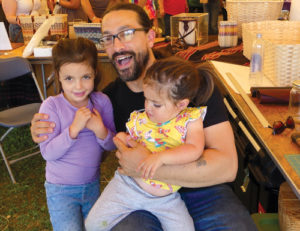November 2019
10. Dream Leader
“That’s not how you do it, but that’s how I do it.” —Gabriel Frey
By Diane Hudson
 “Isn’t there an easier way?” It’s a question Gabriel Frey, twelfth generation Passamaquoddy artist, is frequently asked. “They are well-meaning, but there are no shortcuts to doing what I do.
“Isn’t there an easier way?” It’s a question Gabriel Frey, twelfth generation Passamaquoddy artist, is frequently asked. “They are well-meaning, but there are no shortcuts to doing what I do.
“I use black ash for my baskets. I cut down a basket-quality tree—straight, with little-to-no branches—and carry the log on my shoulder out of the woods. To get the raw material, I pound the log to fracture the fiber within the growth ring. I have to strike every square inch of the tree, all by hand. Once they’ve been removed from the tree, I further refine the individual growth rings by splitting and gauging them to the desired thickness and width.
“What I do has been done for thousands of years.” Black ash is so closely tied to Frey’s culture, it features centrally in the creation story of the Wabanaki people. “Glooskap is a mythical figure, kind of a trickster guy. Legend has it he shot his arrows into the heart of the ash tree. When it split open, our people were created.”
Frey’s talents stretch beyond basketry. “I’ve done a lot of oil paintings and a few charcoal sketches. I’m inspired to use my artistic voice to raise the profile of Maine’s indigenous population, which has been marginalized for so long. I hope to add to our story and, in doing so, enrich Maine culture.”
In early 2019, Frey, 39, won the prestigious United States Artists Award, a $50,000 unrestricted fellowship. He’s come a long way from when he made his first basket at the age of 18. “I told my mom I wanted to go and make a basket when the Maine Indian Basketmakers Alliance (MIBA) offered a workshop in our community. She was like, ‘Yeah, sure.’ When I started working, it was as if I were remembering something I’d done before—a cellular memory.”
His first creation, a traditional “potato basket,” was originally designed for farmers’ use in Penobscot county. “I was always drawn to making work-related baskets. My grandfather was a strict utilitarian. His baskets were tools and meant to be used. Very few basket makers my age were working in this tradition. They were making ‘fancy’ baskets, smaller and more decorative.
“When my grandfather developed emphysema, suddenly there was a time limit on how much I could learn. I went to live and study with him.” Frey remembers vividly the day his grandfather said, I can teach you how to make baskets, but you must learn yourself how you make baskets.
“For the longest time, I followed in my grandfather’s footsteps. Strictly utility. Then I was making a basket for a friend and decided instead of just carving the handle, I’d sand it down. It became a polished handle. You could see the sheen in the wood—so satisfying! I began putting more time into each piece. I worked on the details and finished the edges. Each little thing led to more. A couple of elders said, ‘That’s not how you do it.’ Remembering my grandfather I thought, ‘That’s not how you do it, but that’s how I do it.’
“For us, form has always followed function—the pack basket, for example. Prior to European contact in the U.S., roads were rivers and every family had a canoe. The design of the basket was flat on one side to fit your back and rounded on the other to fit into the hull of the canoe. The form is the function. The purses I make, for which I’m now well-known, are shaped like the pack basket. I’m still doing the same thing, but today, the function is different. They are wearable works of art built within the same tradition that connects people to my homeland in a physical way. This is all part of keeping the cultural history alive and maintaining awareness of what our society looked like prior to European influence.”
Thanks to the $50,000 prize, Frey expects to be able to devote more time to developing newer and more refined forms for current functions. He works another job part-time to support his family. “I also have a small integrative massage practice in the Bangor area. I’m primarily in clinical massage modalities—myofascial release, trigger point, deep tissue massage, and sports massage.” His wife, Suzanne Greenlaw, is a Maliseet doctoral candidate in ethnobiology at the University of Maine. They have two children, Musquon, 6, and Alamosit, 2. “The typical artist demands that you go down into your creative cave and come up after 3 days for food,” Frey says. “I could do that, but I’m content. The children are amazing. You choose your struggles.”
There are many spelling variations of Glooskap: Gluskabe, Gluscabi, Koluscap, Klouscap.
Know more? Share them with us at staff@portlandmonthly.com.







0 Comments